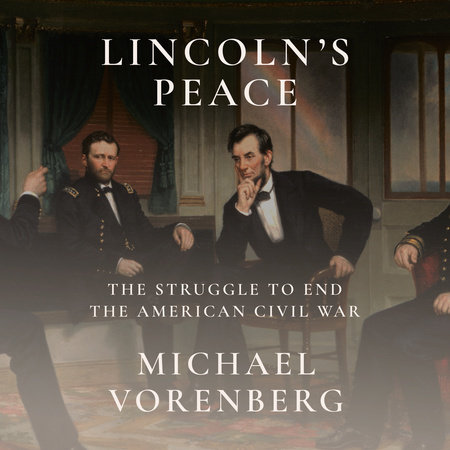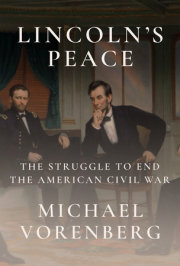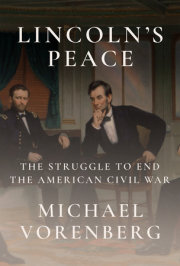1
The Peacemaker
The James River begins as a creek in the hills of northwest Virginia and winds its way to the south and east, picking up speed and breadth until it reaches Richmond, where it slows to still water, bending one way then another. Just below the city, the James enters the Virginia Tidewater. It crests the fall line and drops into boiling rapids. Once at the coastal plain, the river’s waters are brackish and gripped by ocean tides. It flows now more than a hundred miles, meandering through oxbow after oxbow, sending off rivulets, sometimes becoming marshland, and finally reaching a small peninsula located only thirty miles south of Richmond by land: City Point. Here the James meets the Appomattox River, which enters from the west. From City Point, the James, now swollen with the waters of the Appomattox, becomes a wide, slow-moving thoroughfare to the Chesapeake Bay. At the meeting of the James and the Chesapeake, the water is still and shallow, forming a delta with the city of Norfolk on the south side and the region known as Hampton Roads on the north. It is impossible to tell the exact point at which one body of water becomes the other.
President Abraham Lincoln arrived at City Point on March 25, 1865. He made the trip aboard the River Queen, a comfortable side-wheel-propelled steamboat that had been built the year before. Its original owners had intended it to run excursions for the well-heeled between Providence and Newport, Rhode Island. The U.S. Army had leased it for use by dignitaries and top officers. Lincoln knew the ship well. He was also familiar with City Point, Grant’s headquarters. This was not his first visit. But this trip was different. Within days of his arrival, he decided that he would not return to Washington until he had witnessed, or perhaps even orchestrated, the end of the Civil War.
The once-pastoral peninsula of City Point was now a sprawling U.S. Army encampment, the headquarters of Lincoln’s top general, Ulysses S. Grant. For nearly four years, U.S. forces had been waging a devastating war with the Confederate States of America. Grant now believed the end was in sight. For weeks the general had been sending messages to Washington suggesting that Lincoln visit City Point, but until now Lincoln had always politely declined.
He had been slow to open his heart to the possibility that the war might soon end. There had been no sign of a weakening of the enemy’s resolve—certainly not from the Confederate leadership. Back on February 2, Lincoln had met with three emissaries sent by Jefferson Davis, president of the Confederacy. Any wisp of hope for peace that the president may have clung to dissolved as soon the discussion began.
The meeting had been held at Hampton Roads. Lincoln was accompanied by his secretary of state, William Henry Seward. The five men had their discussion on board the River Queen, the same ship that would take Lincoln to City Point seven weeks later. At Hampton Roads on February 2, the Confederates never mentioned a possible surrender. They instead floated the possibility of an alliance between their country and the United States in order to pursue a war against Mexico. Lincoln said that any plan had to involve the southerners’ surrender and their return to “our one common country.” That was not going to happen, the Confederates explained. Lincoln played his one card. The constitutional amendment abolishing slavery had just passed Congress and been sent to the states for ratification. Slavery was certain to end. But if the rebels surrendered and the southern states returned to the Union, the South might get a say in how slavery ended. Maybe gradual instead of immediate emancipation was a possibility in some places. Maybe some former slaveholders could get compensation from the U.S. government for the loss of their human property. But if the rebellion continued, southern whites would have no say in emancipation. The emissaries, all of them slaveholders, were shaken by the news of the amendment, but they stuck to the script that Jefferson Davis had written for them: an independent Confederate nation was a nonnegotiable precondition to peace. They headed back to Richmond. Lincoln steeled himself for more war.
Not just mere weeks or months of war lay ahead, Lincoln thought. The war could go on for years, maybe ages. Late in February, a few weeks after the Hampton Roads meeting, Lincoln brushed off an army supplier angry that he had not yet been paid by telling him that things might be different “if we were nearer the end of the war.” On March 2 Grant reported that Robert E. Lee, Grant’s counterpart in the Confederacy, wanted to meet the general to discuss a “military convention” that might end hostilities. Lincoln kept hope at bay. He suspected—correctly—that Lee was looking for a ceasefire or some other sort of delaying tactic to allow him to join forces with Confederate general Joseph E. Johnston’s army in North Carolina. He had Grant tell Lee that the two generals could meet only if it was about the “capitulation” of Lee’s army. Once Lee heard that, he begged off, just as Lincoln knew he would.
Two days later, and about three weeks before his trip down the James, Lincoln delivered his Second Inaugural. The speech contained the most chilling prediction possible of how long the war might last. Slavery, which was “somehow the cause of the war,” was the nation’s sin. God—or at least justice—might well demand that the country suffer war for as long as Blacks had suffered slavery. The war could continue, perhaps should continue, “until every drop of blood drawn with the lash, shall be paid by another drawn with the sword.” These were not the words of a president with optimism—or an exit strategy.
Yet, to keep up his listeners’ morale, and perhaps his own, he held out hope of an end that would come soon, and with kindness all around. “With malice toward none,” Lincoln urged, the people must “strive on to finish the work we are in” in order to “achieve and cherish a just and lasting peace among ourselves and with all nations.” A peace that was “lasting”—the meaning of that was clear enough. A simple ceasefire would not do. But what was a “just” peace? The word allowed for many meanings. “Just” could mean fairness, as opposed to vengeance, toward one’s former enemies. That meaning was suggested by the “malice toward none” phrase. But “just” could also mean the opposite: retribution in proper measure against those responsible for the war. “Just” also meant moral, and the moral issue at the heart of the Inaugural was slavery or, more precisely, its abolition. No peace could be just or lasting, Lincoln believed, unless it included the end of slavery.
Within two weeks of the Inaugural, Lincoln was regularly making passing predictions of the coming end of the war. On March 17, he said that the recent decision by the Confederacy to allow states to form regiments of enslaved people was a sign that the South was “near the bottom” and the “end is near.” To a Union general in Missouri, on March 19, Lincoln suggested a hands-off approach so that the war might “wind down” there. The next day, he told a Russian diplomat that he expected the war to be over by the end of the year. His secretary of state shared Lincoln’s cautious optimism. Seward dropped the phrase “as the war begins to end” into a letter written to his wife.
Like those around him, Lincoln by late March had become hopeful that the end was quite near, probably because reports from Grant had become increasingly optimistic. When Lincoln left for Grant’s headquarters at City Point on the River Queen, he expected to see the end of the war. “He intended to propose the terms of surrender himself,” one of his companions wrote. “He had made up his mind that this fraternal strife should cease in one way or another.” So high was Lincoln’s confidence that he brought along his wife, Mary, and his young son Tad, no doubt hoping to have them at his side when he toured battlefields and liberated cities. He did not expect to return to Washington until the war was over.
The steamship journey to City Point was rough—a virus or perhaps bad drinking water on the boat made Lincoln feverish and lethargic—but within a day of docking Lincoln was receiving visitors. There was a shine in his eye now, observers remarked, a clear contrast to the melancholy that had deepened the crags of his gaunt face in recent months. He told one of the naval officers that he had “the greatest confidence that the war was drawing to an end.” He was eager to steam up the James toward Richmond, the Confederate capital, or down the Appomattox toward Petersburg, the Confederacy’s main railroad hub and supply depot. Rear Admiral David Dixon Porter, who was at City Point at the time, offered to be his guide. Porter was the most esteemed Union naval commander next to Vice Admiral David Farragut, Porter’s adopted brother, who was currently commanding U.S. naval forces in the Gulf of Mexico. Porter knew that it might be some time before Lincoln could see Richmond or Petersburg. U.S. troops had been laying siege to Petersburg for months and seemed no closer to a breakthrough. Richmond was well defended by Lee’s Army of Northern Virginia. Jefferson Davis, the president of the Confederacy (or “so-called president,” as Lincoln called him), still resided in the city, only thirty miles away from City Point. He had no plans to leave.
With General Grant assuring him that Petersburg and Richmond would soon fall, Lincoln began planning for the end of the war. On March 28, he held an impromptu meeting on board the River Queen with Grant, Porter, and Major General William T. Sherman. Sherman’s presence at City Point was unexpected. Neither he nor Lincoln knew that the other would be there. Sherman had come from North Carolina, where the army he was commanding was stalking the force under the command of Joseph E. Johnston. He had planned to talk with Grant about coordinating their efforts and keeping Lee and Johnston from joining forces. Sherman and Lincoln had met only once before—a brief encounter four years earlier. They had not been impressed with each other. There was still some distrust there, despite all that each had done to bring the Confederates to heel. When Lincoln first saw Sherman at City Point, he asked in dismay why the general had abandoned his army in North Carolina. It took some soothing from Grant to relieve Lincoln’s anxieties. Sherman’s men were as firm for a fight as ever. They could make do without their commander for a few days.
The March 28 meeting on board the River Queen was the first and only time that Lincoln told his top generals how he wanted the war to end. The one point that he stressed above all was lenience toward the Confederates. He worried that vengeful U.S. commanders would “exact severe terms,” as he had recently told his cabinet. In the spirit of “malice toward none,” the concluding message of his Second Inaugural, Lincoln told the officers aboard the River Queen that he wanted “submission” but “no more bloodshed.” The enemy were to be treated “liberally all round.” “Get the deluded men of the rebel armies disarmed and back to their homes,” Lincoln predicted, and “they won’t take up arms again.” “We must ‘let ’em up easy.’ ”
The metaphor came from wrestling, a sport Lincoln had mastered as a young man on the frontier. His physical prowess had given him an advantage, but his skill came just as much from knowing when not to fight. At twenty-two, he grudgingly accepted the challenge of husky Jack Armstrong, the head of the “Cleary Grove boys” of New Salem, Illinois. People argued for years about who had won the match, but all agreed on how it had ended. One of the men simply let the other “up easy.” From that point on, Lincoln, a new arrival to New Salem, was fast friends with Armstrong and his “boys.” Like a worn-out wrestler, the Confederacy would soon concede the match. Lincoln would let ’em up with honor. A friendly, lasting peace would ensue.
The commanders understood what Lincoln was asking of them. But were even the leaders of the rebellion to be spared? they wondered. It was one thing to go easy on the ordinary Confederate soldiers, whom Lincoln called the “deluded men,” but were they really supposed to be so kind to those who had done the deluding? Was even Jefferson Davis to get a free pass?
What to do with Jeff Davis? That could be tricky, Lincoln conceded. He knew that many in the Union wanted Davis hanged. But executing Davis would only keep animosities aflame and prolong the war, Lincoln worried. The answer was to let Davis escape the country. Eventually, peace would calm tempers, and people would forget about the Confederate leader. Yet Lincoln could not explicitly order his commanders to let Davis go. So he dropped a large hint, in the form of one of his stories. There was a fellow who had taken the pledge against liquor, Lincoln began. When a friend offered him a drink, he asked for lemonade. His host pointed to a brandy bottle and offered to add some to the lemonade to make it more “palatable.” The man would not object, he said, so long as the friend could add it “unbeknown” to him. The story was uncharacteristically unfunny for Lincoln. But the message was clear: if possible, the military men should let Davis slip out of the country “unbeknown.” Lincoln’s story concluded the meeting aboard the River Queen.
The president knew that other delicate decisions beside the handling of Davis lay ahead. He preferred to handle them as they came rather than get bogged down in discussions of the “what ifs.” This pragmatic side of Lincoln had served him well, but if he really meant to end the war, he had to start tackling some of the thornier problems now. Or so he was told by Secretary of State Seward, who arrived at City Point on March 30, two days after Lincoln’s meeting with the military commanders.
No one had invited Seward. He, like Lincoln, was hoping to be part of any end-of-war negotiations that might take place. Also, like Lincoln, he saw the trip to City Point as a bit of adventure. He, too, brought his wife and some family members. But his main reason for coming was to advise Lincoln, even if Lincoln had not asked for any advice. Seward regarded himself as Lincoln’s most learned and trusted advisor. Maybe he was. Seward was both an expert in international affairs and a savvy politician. He and Lincoln had gotten off to a rocky start. The onetime New York governor and U.S. senator believed that he, not the inexperienced one-term congressman from Illinois, should have received the Republican presidential nomination in 1860. He took the position as secretary of state assuming that he would do most of the governing of the nation; Lincoln would be the figurehead. The president quickly disabused him of that notion, slapping him down in early April 1861 when he pushed for a solution to the secession crisis that might have entangled the United States in a war with France and Spain. Eventually, the two men came to respect each other; then they became very close friends. Only Seward had been with Lincoln when the president met with the southern envoys at Hampton Roads back in February 1865. It was natural that he would assume that he was needed at City Point in case there were to be more such meetings. Also, if Lincoln really was going to try to make some kind of peace, he needed to be briefed about relevant matters of international law.
On March 31, Seward met with Lincoln on the River Queen. There is no record of what the two men discussed. Almost certainly, though, international law was part of the conversation. Seward had appointed himself Lincoln’s tutor on the reigning theories of war-ending found in dusty tomes by Enlightenment-era European philosophers like Hugo Grotius, Emmerich de Vattel, and Samuel Pufendorf. Lincoln was less than eager for a lecture from Seward. Ever the pragmatist, he had no use for archaic theories about how to end a war. He wanted to settle a peace in whatever way that circumstances of the moment allowed. He had joked with Admiral Porter before Seward’s visit that he knew Seward would “talk to me all day about Vattel and Puffendorf [sic] . . . , and I don’t want to hear any more of that.” Lincoln had been right. Seward knew that Lincoln might soon be meeting with Jefferson Davis. If that happened, Seward believed, the president did indeed have to follow the established rules of war-ending. Technicalities mattered—at least to Seward. For example, the president could demand certain military conventions, like disarmament and prisoner release, but he must not arrange anything that suggested an agreement between nations, as that would add legitimacy to Davis’s claim—so far rejected by the Lincoln administration—that the Confederacy was a nation. Seward had been over this ground with Lincoln before, most recently in preparation for the meeting with Confederate emissaries at Hampton Roads two months earlier. But now the prospects of a meaningful settlement were much brighter, and Seward might not be there to help with the finer points. Lincoln would have listened courteously but impatiently. The end of war need not be a pas de deux, he thought; it could be a manly handshake. The meeting did not last long. Seward then returned to Washington.
Lincoln was thinking of heading back, too. By April 1, he had been away from the capital for a week—his longest presidential sojourn to date. Mary was returning that day, though she was leaving Tad behind. She had had enough of the mud and of Grant’s wife, Julia, whose efforts at charm and kindness she found pitiful. Mary’s decision to go may have clinched Lincoln’s decision to stay. There had been a particularly embarrassing incident during an excursion on horseback a few days earlier when Mary upbraided a general’s wife for presumptuously riding beside Lincoln for a few paces. The president welcomed the chance at a separation. He also was still hoping to be in Virginia for the close of the war. He had written to Secretary of War Edwin Stanton, “I begin to feel that I ought to be at home, and yet I dislike to leave without seeing nearer to the end of General Grant’s present movement.”
At four-thirty in the morning on April 3, Lincoln was awakened by the sounds of far-off explosions coming from up the James. It was the Confederates, someone told him. They were blowing up their own “ironclads,” the vessels used for river warfare, to keep them from being seized by U.S. forces. Petersburg had finally fallen, and Lee’s army was abandoning Richmond. The moment Lincoln had hoped for had come. “Thank God that I have lived to see this!” Lincoln exclaimed.17 He believed that the “end of the war was now in sight.”
Copyright © 2025 by Michael Vorenberg. All rights reserved. No part of this excerpt may be reproduced or reprinted without permission in writing from the publisher.






